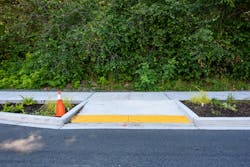What is a Bump Out?
By Ileana Garnand, Digital Editor
Drivers and pedestrians alike may not think much about the parts of roads where sidewalks and curbs become wider, but this design serves a serious purpose. A bump out, also known as a curb extension, increases safety and reduce environmental damage.
What is a Bump Out?
A bump out is a traffic calming design technique that extends the curb line and sidewalk into the roadway, narrowing the street. It is often used at crosswalks, intersections and mid-block locations. Bumps outs can be used on downtown, neighborhood and residential streets of all sizes.
This feature makes pedestrians more visible to vehicles and provides a protected area with a shorter crossing distance. Without a bump out, passersby could be less visible due to parked cars or other street obstructions.
What are the Benefits of a Bump Out?
Bump outs serve as a visual cue for drivers to stay aware of their surroundings and slow down. The narrowed road width encourages slower speeds for through traffic and turning vehicles. Bump outs also protect cars parked on the road and prevent vehicles from parking too close to an intersection.
The design provides additional sidewalk space for various uses, including curb ramps, utilities and traffic control, bus stops, bicycle parking and sidewalk cafes. Bump outs also create more room for pedestrians to queue at a crosswalk.
What are the Different Types of Bump Outs?
Bump outs can come in various designs. The National Association of City Transportation has identified four different types, although the list is not all-encompassing.
Gateway bump outs are placed parallel at intersections that lead into a residential or low-speed street. They are used to signal the transition to a slower paced road.
Pinpoint bump outs, also called chokers, are also parallel but located mid-block. They slow traffic speeds and add public space, including pedestrian crossings.
Chicane bump outs create a series of tight, alternating bends in the roadway that slow vehicle speeds considerably. Whether located mid-block or at an intersection, they make more public space for things like benches, bicycle racks and crosswalk queueing.
Bus bulbs extend a bus stop into a street’s parking lane, allowing buses to stop and board passengers without leaving the travel lane. This makes public transit faster and more reliable by eliminating the need to merge in and out of traffic.
How are Bump Outs Good for the Environment?
Bump outs slow down storm water runoff and help mitigate environmental hazards. Street designers can include rain gardens, bioswales and trees within bump outs to absorb rain and snow. This is a cost-effective approach that mimics the absorption and filtering capabilities of natural, undeveloped areas.
When storm water and snow melt are left unmanaged in the street, they can pick up trash, oil, road salt and other contaminants. Polluted runoff travels through storm drains and merges into streams, rivers, lakes and the ocean. This is one of the “greatest threats to clean water in the U.S.,” according to the Environmental Protection Agency.
Extreme weather events are happening more often due to climate change, as identified by the town of Millbury, Massachucettes. Bump outs can help decrease their impact, acting like a sponge that captures and holds storm water to slowly absorb it over time.
Trees planted within bump outs also provide shade and clean air to the surrounding community.
Sources: City of Toledo, Town of Millbury, City of Minneapolis, National Association of City Transportation Officials
